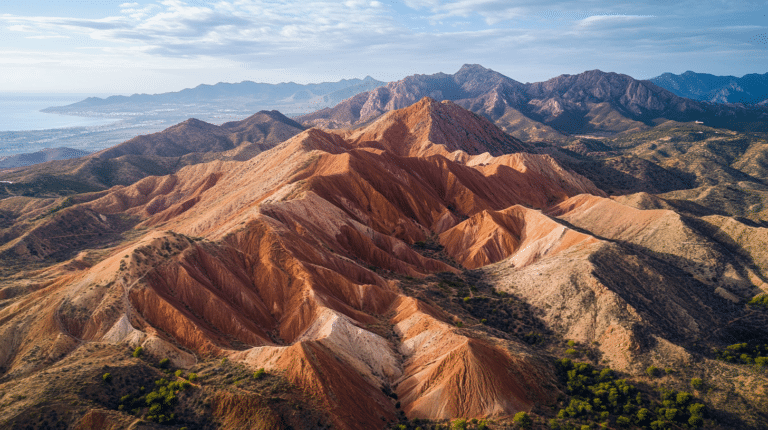Sierra Bermeja: Estepona’s Natural Gem
Nestled just behind the charming coastal town of Estepona lies a natural wonder that often goes unnoticed by visitors to the Costa del Sol. Sierra Bermeja, with its distinctive reddish hue and rich biodiversity, offers a captivating escape into nature that rivals the beauty of the region’s famous beaches. This article will take you on a journey through this remarkable mountain range, highlighting its unique features, diverse ecosystems, and the unforgettable experiences it offers to nature enthusiasts and casual explorers alike.
The Geological Marvel of Sierra Bermeja
Sierra Bermeja stands out not only for its striking appearance but also for its geological significance. The mountain range is primarily composed of peridotite, a rare type of rock that gives the sierra its characteristic reddish color. This unique composition makes Sierra Bermeja one of the largest peridotite masses in the world, creating a distinct ecosystem that supports a variety of endemic plant species found nowhere else on Earth.
The presence of peridotite has shaped the landscape over millions of years, resulting in dramatic formations and steep slopes that offer breathtaking views of the Mediterranean Sea and the surrounding countryside. Geologists and nature lovers alike are drawn to Sierra Bermeja to study and admire this rare geological phenomenon.
Biodiversity: A Haven for Rare Flora and Fauna
The unique soil composition of Sierra Bermeja has given rise to an extraordinary array of plant life. The mountain range is home to over 1,300 plant species, many of which are endemic to the area. One of the most notable inhabitants is the Spanish fir (Abies pinsapo), a relic species from the Tertiary period that survives only in a few isolated pockets in southern Spain.
Wildlife enthusiasts will also find plenty to observe in Sierra Bermeja. The area serves as a habitat for various bird species, including eagles and vultures, as well as mammals such as wild boars and Spanish ibex. The diversity of ecosystems within the mountain range, from Mediterranean forests to high-altitude zones, supports this rich array of fauna.
Exploring Sierra Bermeja: Hiking Trails and Viewpoints
For those eager to experience the natural wonders of Sierra Bermeja firsthand, the mountain range offers a network of well-maintained hiking trails suitable for various skill levels. One of the most popular routes is the ascent to Los Reales, the highest peak in Sierra Bermeja at 1,452 meters above sea level.
The trail to Los Reales takes hikers through diverse vegetation zones, offering panoramic views that stretch from the African coast to the Sierra Nevada mountains. Along the way, informative signs provide insights into the unique flora and geology of the area, making the hike both educational and visually stunning.
For those seeking a less strenuous experience, the Estepona hiking trails in the lower reaches of Sierra Bermeja offer gentler paths through pine forests and Mediterranean scrubland. These trails are perfect for family outings and provide ample opportunities for birdwatching and plant identification.
Conservation Efforts and Sustainable Tourism
The ecological importance of Sierra Bermeja has not gone unnoticed by conservationists. Efforts are underway to have the area designated as a National Park, which would provide additional protection for its unique ecosystems. Currently, parts of Sierra Bermeja are protected as a Natural Park, but many believe that national park status is necessary to ensure the long-term preservation of this natural treasure.
Visitors to Sierra Bermeja are encouraged to practice responsible tourism by staying on marked trails, not disturbing wildlife, and carrying out any trash. Local conservation groups often organize guided tours and educational programs, offering visitors a deeper understanding of the area’s ecological significance while promoting sustainable tourism practices.
Seasonal Highlights in Sierra Bermeja
Each season brings its own charm to Sierra Bermeja, making it a year-round destination for nature lovers:
- Spring: Wildflowers carpet the mountainsides, and the air is filled with the songs of migratory birds.
- Summer: The higher altitudes offer a cool respite from the coastal heat, perfect for early morning hikes.
- Autumn: The changing colors of deciduous trees create a spectacular display, especially in the Spanish fir forests.
- Winter: Occasional snowfall transforms the landscape, offering a rare glimpse of snow-capped peaks near the Mediterranean coast.
Connecting with Local Culture
A visit to Sierra Bermeja also provides an opportunity to explore the rich cultural heritage of the surrounding area. The nearby white villages, such as Genalguacil and Jubrique, offer a glimpse into traditional Andalusian life. These picturesque towns, with their narrow streets and whitewashed houses, are known for their artisanal crafts and local festivals that celebrate the region’s connection to the land.
For those interested in the area’s cultural offerings, the Estepona culture scene provides a perfect complement to the natural beauty of Sierra Bermeja. The town’s museums and art galleries showcase both traditional and contemporary works, often drawing inspiration from the surrounding landscape.
Planning Your Visit to Sierra Bermeja
When planning a trip to Sierra Bermeja, consider basing yourself in Estepona or one of the nearby coastal towns. This allows you to combine beach relaxation with mountain adventures, experiencing the best of both worlds that the Costa del Sol has to offer.
For the best hiking experiences, spring and autumn are ideal, offering mild temperatures and clear skies. However, each season has its unique appeal, and with proper preparation, Sierra Bermeja can be enjoyed year-round.
Remember to bring appropriate hiking gear, including sturdy shoes, sun protection, and plenty of water. It’s also advisable to check local weather conditions and trail status before setting out, as conditions can change rapidly in mountain environments.
Conclusion: A Natural Treasure Awaiting Discovery
Sierra Bermeja stands as a testament to the incredible natural diversity of the Costa del Sol region. Its unique geology, rich biodiversity, and stunning landscapes offer a compelling alternative to the area’s famous beaches and resorts. Whether you’re an avid hiker, a nature photographer, or simply someone looking to experience the untamed beauty of southern Spain, Sierra Bermeja promises an unforgettable adventure.
As you plan your visit to the Costa del Sol, be sure to set aside time to explore this natural gem. The memories of red-hued peaks, rare flora, and panoramic vistas will stay with you long after you’ve returned home. Sierra Bermeja is more than just a mountain range; it’s a living museum of geological and ecological wonders, waiting to be discovered by those who venture beyond the coastline.
For those eager to delve deeper into the natural wonders of the region, don’t miss the opportunity to discover Estepona’s hidden gems, which often include lesser-known trails and viewpoints in Sierra Bermeja and its surroundings. The combination of coastal charm and mountain majesty makes Estepona and Sierra Bermeja a truly unique destination on the Costa del Sol.







